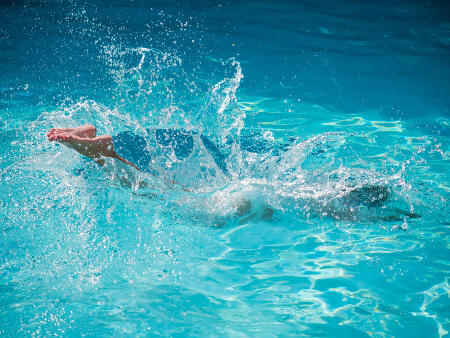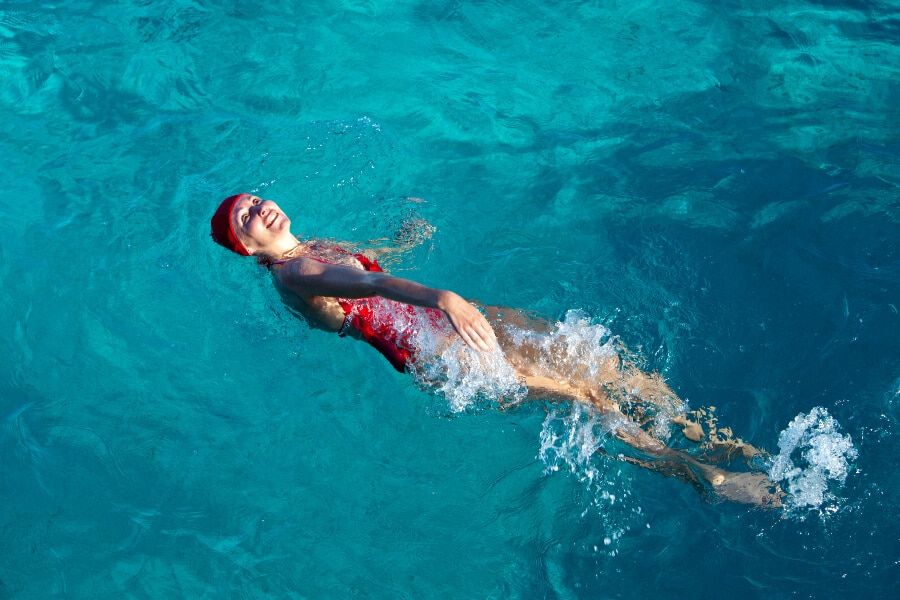As I moved through the water using an improvised breaststroke, I could see the teenage lifeguard at the other end of the pool eyeing me.
“I have no idea what the hell I’m doing,” I yelled to her as I inched closer.
She looked down with a mixture of shock and horror, and I realized I may have frightened her. She was probably thinking she’d have to jump in and rescue me—someone’s mom—at any minute.
I didn’t know what I was doing. And that was the point.
“I’ve decided to take up lap swimming,” I tried to clarify, treading water below her perch and feeling a little breathless after my first 25-yard lap. “I’m just going to be toodling about,” I said. “I do know how to swim, but don’t’ worry, I’m not going to drown.”
“Oh, ok,” she said, still looking a little unsure. “That’s cool.”
So here I was, wedged like a Christmas ham into a tighter-than-tight, bright turquoise one-piece procured from Poshmark. My hair was squashed into a swim cap, and I could already feel the lasting imprint around my eyes from my foggy goggles.
I was uncomfortable. I didn’t know what I was doing. And that was the point.
I’d been sidelined with a back injury since the early days of the pandemic, which had forced me to give up my beloved tennis. I’d been walking daily, but I longed to feel my heart race and my muscles sore from exertion. I joined the gym to see if I could manage swimming.
Though I love the water and that feeling of effortless buoyancy, I had never learned to properly swim laps. I could doggie paddle and improvise strokes, but not real, face-in-the-water lap swimming.
Read More: Rebuilding a Life: The Unappreciated Type of Support That Helps You Move Forward
Oh, How the Tables Have Turned
“Maybe you can come with me to the pool,” I said to my son after my first attempt at lap swimming. “Give me some pointers. I have no idea how to turn around at the end of the pool. How do you do that?”
“A flip turn?”
“Yes, a flip turn,” I said. “I need to know how to do that.”
“It’s easy,” he said, not looking away from his video game.
“Well, can you show me?” I asked.
“Oh, how the tables have turned,” he said, giving me a sly smile.
They had indeed.
Running Laps—but in the Water
A few months earlier, when my son had announced he was joining the swim team, my husband and I both had our reservations. We gently questioned his decision, trying not to discourage him.
It didn’t go well.
“You think I’m going to embarrass myself,” he said, defiantly staring us down.
To him, it wasn’t important that he be good at something before trying it.
“It’s like track—running laps, but in the water,” I tried to reason, remembering all those summer days spent cajoling him to get ready for swim lessons. “I’m just not sure you’ll like it.”
We were proved wrong. Our son took to the water like a fish.
At his first swim meet, I watched in amazement as he glided through the water in graceful, meditative strokes. The meet itself was a hive of activity and energy—teammates yelling and clapping, buzzers and bells ringing—but through all this, the swimmers plodded on, their faces gracefully turning in and out of the water to take a breath.
I don’t remember where he placed because I was too mesmerized by his methodical movements back and forth across the pool. And it didn’t seem to matter to him either.
By questioning his interest in the swim team, I failed to see that he was confident about trying something new. I was thinking about how hard it would be, and—it pains me to say this—I was projecting my own fears. To him, it wasn’t important that he be good at something before trying it. He was brazen and brave.
As parents, these are the type of lessons we try to impart, but along the way, I’d forgotten them myself.
Mastering the Kickboard

I’m back at the pool, intent on mastering the kickboard.
“How do you use this? Am I doing it right?” I yell up to my new BFF, the 16-year-old lifeguard.
“Turn it with the pointy end forward and hold it out in front of you like this,” she mimes, talking slowly and very loud so everyone turns to her then to me.
I can feel my face flush, sure that all eyes are on me.
An older man in the lane next to mine hears our conversation, grabs his kickboard from the deck, and holds it in front of himself.
“Like this,” he says, demonstrating the correct orientation and giving me a gentle, encouraging smile.
I push forward with the board and use steady kicks to propel myself to the other end of the pool. Sooner than I expect, my breath is short and my legs feel heavy from the effort.
The Big Plunge
After a few laps with the kickboard, I set it aside and take another slow lap using the backstroke—the only “real” swimming stroke I know. I imagine my arms gracefully arching up over my head, my legs, strong from daily walks, pushing through the water.
Then I turn over and gingerly put my face down into the water. I try to relax, letting out air and then turning my head to the side to breathe. It’s unnatural to me, and each time I put my face in the water, I feel panic rising. Coordinating my breath, arms, legs, and head—all of it seems impossible for the moment, so I turn over again and continue along on my back, watching for the fluttering lane flags that tell me I’m close to the wall.
As I float along, I flash back to my childhood, when my sister and I would go to our town’s public pool. My mom would drive home from work for lunch then drop us at the pool for the afternoon, where we were left to our own devices.
After a while, I even forget about the other swimmers around me.
We’d spread a blanket on the grass and set up camp, eating Twizzlers from the snack bar and flirting with boys. We’d take turns on the diving board, encouraging each other to jump from the highest level. Without our parents there to talk us out of it, we egged each other on, mastering a straight-legged plunge and pinching our noses to keep out the stinging water.
One of our favorite games was guiding each other around the pool on our backs. My sister would place her hands gently under my lower back and I’d recline, fully relaxed and floating with my eyes closed. She’d walk me slowly around the pool and, after a few minutes, I’d open my eyes to see if I’d guessed correctly as to where I’d end up.
Daydreaming of those days helps me finish my laps, and after a while, I even forget about the other swimmers around me. I wasn’t worrying if the lifeguard thought I was an idiot or if anyone was judging my form (or lack thereof).
My legs are wobbly as I pull myself onto the deck, but I can’t help but feel proud. I swam for 25 minutes. I relished moving my body in a new way and feeling my heart thump like it hadn’t in a long time. For a short while, the burden of my injury and my fear were both lifted.
I don’t know if I’ll become a regular swimmer. For now, I’m content to float and flail, and lean on a kickboard, to feel both the effort and effortlessness of being a beginner.
Like those summer days spent jumping feet first from the high dive, it felt good to just take the plunge.
Read More: The Mighty Mermaids Swam the English Channel: “We Smoked It!”
***
Rachel Bucci is a writer whose essays have been featured by Brevity, The Dirty Spoon and Oregon Humanities. As a freelance journalist she has written about food, travel and interiors for the Oregonian, Oregon Home, the New York Times, Oregon Agricultural Progress, 1859 Magazine and more. You can find her at rachelbucci.com.





















0 Comments